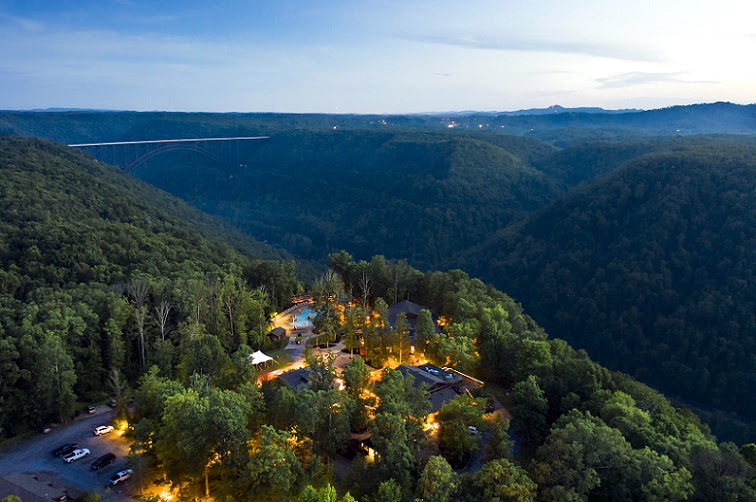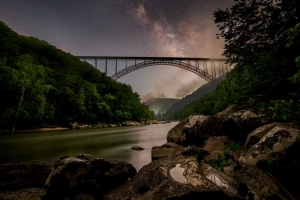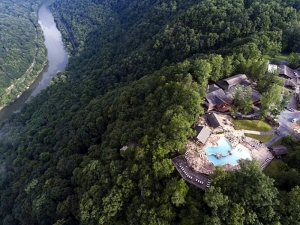
FAYETTEVILLE, W. Va. — The nation's newest national park, the New River Gorge National Park and Preserve, is full of secrets, surprises, historic sites, and charming quirks, and chances are good that all of these are within just a day’s drive.
The park is within an eight-hour drive of nearly 60 percent of the U.S. population. Drive time is approximately five hours from Cleveland, four from Cincinnati, four from Charlotte, five from Washington, D.C., six from Indianapolis, and eight from New York City.

Roger Wilson has roamed the New River Gorge for most of his life, as did generations of his family before him. When he’s not running Adventures on the Gorge adventure resort adjoining the park boundary, Wilson, an avid hiker, enjoys exploring the vast Appalachian destination that has become a mecca for outdoor recreation.
“This is a wild place, and it seems like there’s historical significance or wonderful weirdness around every bend in the river or along a trail,” Wilson says. “The New River Gorge begs to be explored slowly, immersively, and with wonder.”
Here are 12 facts about the New River Gorge that may surprise visitors.
- The New River is among the oldest rivers in the world, with some estimates dating it back 360 million years.
- Groundbreaking historian and scholar Dr. Carter G. Woodson shoveled coal in the Nuttalburg and Kaymoor mines before founding Negro History Week, the precursor to Black History Month. The historian is known as the “Father of Black History.” Visitors can learn more about the black heritage of the region through an audio driving tour with stops at 17 sites, such as the Quinnimont Missionary Baptist Church, Hawks Nest Workers Memorial and Grave Site, John Henry Park, and Hinton Depot.
- The Town of Thurmond, now a well-preserved ghost town, was incorporated in 1903, and it will mark its 120th anniversary in 2023. Listed on the National Register of Historic Places, it was considered the region's heart and the primary stop along the C&O Railway. At its peak, it boasted two hotels, two banks, restaurants, a clothing store, dry-goods stores, and business offices. The boomtown went bust with the onset of the Great Depression and the increasing popularity of travel by private automobile. The National Park Service has preserved many of the town’s buildings, including the depot, which is now a visitor center.
- Henry Ford once leased the mines in the town of Nuttallburg, as part of the automobile tycoon’s efforts to control all aspects of automobile production. His Fordson Coal Company improved the mine and town over eight years, but Ford sold his interests in the mines when railroad transportation of the coal became unreliable.
- Surrounded by water whenever the river is running high, Red Ash Island was a quarantine site during a smallpox epidemic during the 1870s. Some 30 percent of people living in New River Gorge communities were infected. Patients were sent to a town near the island to live until they recovered or died. Visitors can still see gravestones of the victims of smallpox as well as victims of mine disasters and the 1918 Spanish flu epidemic.
- The New River Gorge Bridge is the most-photographed site in the state of West Virginia. The distinctive 3,030-foot-long, 876-foot-high bridge is the longest single-arch bridge in the Western hemisphere and the third-longest single-arch bridge in the world. For a bird's-eye view of the New River Gorge, visitors can take a guided walk along the bridge on a catwalk beneath its surface. The life-changing bridge cut travel time across the gorge from 45 minutes to less than one minute, positively impacting lives and improving travel safety for residents.
- The park’s Sandstone Visitor Center is a registered monarch butterfly waystation with a well-maintained native garden planted with milkweed to attract the endangered butterflies to the site. Monarch populations have been in decline due to habitat loss. One of four visitor centers in the national park, the Sandstone Visitor Center is dedicated to showcasing the region’s natural and cultural history.
- Legendary advocate for workers’ rights, Mother Jones trekked from coal camp to coal camp as a delegate for the United Mine Workers of America.
- In 1755, Mary Draper Ingles endured and survived captivity by the Shawnee nation of Ohio and eventually made her way back to the New River after a harrowing escape.
- The region is home to one of the world’s first resorts dedicated to outdoor adventures, Adventures on the Gorge. Located adjacent to the national park boundaries and less than three miles from the Canyon Rim Visitor Center, the resort features more than two dozen guided adventures, a variety of accommodations, restaurants, and shops.
- Commercial whitewater rafting began in 1968, and as the sport grew in popularity, the region became known as a whitewater rafting destination. It still is, with rafting from spring to fall on the New River and the nearby Gauley River.
About Adventures on the Gorge

Named one of the top adventure resorts in the country by U.S. News & World Report, Adventures on the Gorge is located on more than 350 acres along the rim of the gorge near Fayetteville, West Virginia.
It provides an array of outdoor experiences, including whitewater rafting on the New and Gauley rivers, aerial adventures, rock climbing, rappelling, kayaking, stand-up paddle boarding, fishing, mountain biking, and hiking. Restaurants, bars, and shops, as well as a small-group conference center, and visitors can choose from a variety of accommodations and vacation packages.




























